Residue from vehicle tires contains a chemical highly toxic to several important species of fish when it washes into streams, says new Canadian research.
"It seems almost like the fish are suffocating from the inside," said University of Saskatchewan toxicologist Markus Brinkmann. "It's not the nicest thing to observe."
Brinkmann's research has added to a growing body of research looking into the effect of tire residue when it enters the environment.
A link between fish fatalities and such residue was first revealed in a 2021 paper that examined deaths of coho salmon in Washington state in streams subject to heavy rainfall runoff from urban areas. That paper concluded the kills were due to a chemical called 6PPD-quinone, a contaminant formed from the residue tires leave on roads as they wear.
Brinkmann found the same effects on rainbow and brook trout, two culturally and economically important fish widespread in North America.
The chemical seems to inhibit breathing, he said.
"There's plenty of oxygen (in the water). They seem not able to use the oxygen to do what a normal organism normally does, which is breathe."
The fish appear to gasp. They swim erratically and in circles, then die.
Brinkmann said the effects occur at very low concentrations, less than a millionth of a gram per litre of water.
"That's a pinch of salt in an Olympic pool, basically."
That much 6PPD-quinone can be found outside the lab.
"You do find these concentrations in surface waters," Brinkmann said.
Not all fish are vulnerable. Brinkmann found Arctic char and sturgeon were much more tolerant of 6PPD-quinone. Others have found the same for chum salmon.
As well, the effect is greatest in streams that pass through or near urban areas. Rivers dilute storm runoff enough to reduce the threat.
However, urban streams that are also important fish habitat and spawning areas are common in Canada, said Brinkmann.
"There should be opportunities to observe the very same thing."
Although the chemical has been used in tires since the 1950s, scientists have only recently begun noticing impacts from it and other tire residues.
That's because environmental legislation has removed other fish stressors, exposing the effect of 6PPD-quinone, Brinkmann said. Analytical methods have also improved, allowing researchers to isolate ever-smaller concentrations.
Brinkmann also suggested that fish populations subject to high levels of tire residue died off long before science had a chance to ask why. The dead salmon in Washington were only studied because those streams, once important coho habitat, had recently been restocked.
He said scientists are just starting to ask questions about tire residue contaminants.
Almost nothing is known about the effects of long-term exposure to sublethal levels. Researchers know little about how these chemicals behave -- whether they concentrate in fish tissue, persist in the environment or simply dissipate.
Their impacts have only been studied for a handful of species. Brinkmann said he hopes to expand his work to look at how 6PPD-quinone affects a wide variety of fish, from prey species like flathead minnows to sought-after game fish like lake trout and walleye.
Nor have products made from used tires been studied to see if they produce similar residue. Although rubber-crumb products coat tire particles with plastic, Brinkmann said that coating could deteriorate.
"If these particles are breaking down in the environment and the coating comes off, then you get the chance for 6PPD to leach out."
Brinkmann's paper was published in the journal Environmental Science and Technology.
This report by The Canadian Press was first published March 16, 2022.
-- Follow Bob Weber on Twitter at @row1960
Bob Weber, The Canadian Press



